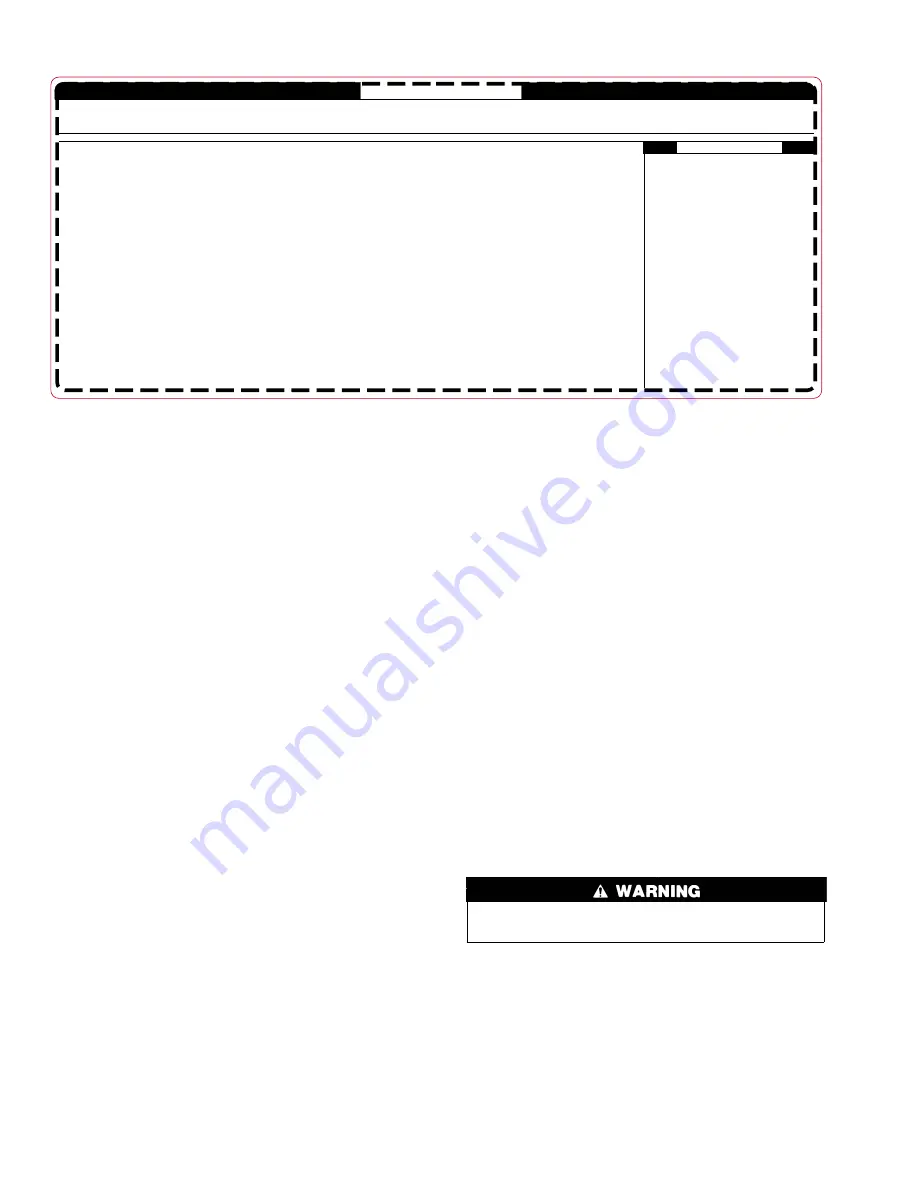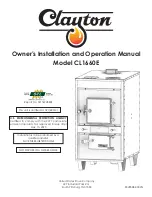
NOTE:
If the polarity is not correct, the STATUS LED on the
control will flash rapidly and prevent the furnace from heating.
The control system also requires an earth ground for proper
operation of the control and flame-sensing electrode.
The 24-v circuit contains an automotive-type, 3-amp fuse located
on the control. (See Fig. 32.) Any shorts of the 24-v wiring during
installation, service, or maintenance will cause this fuse to blow. If
fuse replacement is required, use ONLY a 3-amp fuse. The control
LED will display status code 24 when fuse needs to be replaced.
Proper instrumentation is required to service electrical controls.
The control in this furnace is equipped with a Status Code LED
(Light-Emitting Diode) to aid in installation, servicing, and
troubleshooting. It can be viewed through the sight glass in blower
access door. The amber furnace control LED is either ON
continuously, rapid flashing, or a code composed of 2 digits. The
first digit is the number of short flashes, the second digit is the
number of long flashes.
For an explanation of status codes, refer to service label located on
blower access door or Fig. 50, and the troubleshooting guide which
can be obtained from your distributor.
A brief Troubleshooting Guide is on page 46.
For 2-Stage Variable Speed ECM Controls the stored status codes
will NOT be erased from the control memory, if 115- or 24-v
power is interrupted. The control will store up to the last 7 Status
Codes in order of occurence.
1. To retrieve status codes, proceed with the following:
NOTE:
NO thermostat signal may be present at control, and all
blower-OFF delays must be completed.
a. Leave 115-v power to furnace turned on.
b. Remove outer access door.
c. Look into blower access door sight glass for current amber
LED status. Removing blower access door will open
blower access door switch and terminate 115-v power to
control so that status code is not displayed.
d. Remove blower access door.
e. Manually close blower access door switch.
NOTE:
The Status Codes cannot be retrieved by disconnecting
the limit switch or draft safeguard switch. To retrieve Status
Codes, follow the procedure below.
2. Turn Setup Switch, SW1-1 “ON.”
3. Manually close blower access door switch.
4. Control will flash up to 7 Status Codes.
5. The last Status Code, or 8th Code, will be Code 11.
6. Turn SW1-1 “OFF.”
7. A continuously-lit Amber LED will appear and indicates
proper operation.
8. Release blower access door switch, install blower access door
and replace outer door. Or, refer to the SERVICE label on the
front of the blower access door for more information.
Component Self-Test
Component Test can ONLY be initiated by performing the
following:
1. Remove outer access door.
2. Remove blower access door.
3. Remove the wire from the “R” terminal of the control board.
4. Turn Setup Switch, SW-1-6 “ON.”
5. Manually close blower access door switch.
Blower access door switch opens 115-v power to control. No
component operation can occur unless switch is closed. Caution
must be taken when manually closing this switch for service
purposes.
Failure to follow this warning could result in electrical shock,
personal injury, or death.
6. Component Test will function as follows:
a. Inducer motor starts on high-speed and continues to run
until step (d.) of component test sequence.
b. Hot surface igniter is energized for 15 sec, then de-
energized.
c. Blower operates for 10 sec, then turns off.
d. Inducer motor goes to low-speed for 10 seconds, then turns
off.
To initiate the component test sequence, shut
OFF the room thermostat or disconnect the "R"
thermostat lead. Reset power and then put setup
switch "SW1-6" in the ON position to start the
component test sequence. Once initiated the
furnace control will turn the inducer ON at high-
heat speed. The inducer motor will run for the
entire test. The hot surface igniter and blower
motor will be turned ON for 15 seconds each.
When the blower is turned OFF the inducer will
be switched to low-speed for 10 seconds. When
the component test is completed one or more of
the following codes will flash.
LED CODE
EACH OF THE FOLLOWING STATUS CODES IS A TWO DIGIT NUMBER WITH THE FIRST DIGIT DETERMINED BY THE NUMBER OF SHORT FLASHES AND THE SECOND DIGIT BY THE NUMBER OF LONG FLASHES.
STATUS
11 NO PREVIOUS CODE - Stored status codes are erased automatically after 72
hours or as specified above.
12 BLOWER ON AFTER POWER UP (115 VAC or 24 VAC) -Blower runs for 90
seconds, if unit is powered up during a call for heat (R-W/W1 closed) or
(R-W/W1 opens) during blower on-delay period.
13 LIMIT CIRCUIT LOCKOUT - Lockout occurs if a limit, draft safeguard, flame
rollout, or blocked vent switch (if used) is open longer than 3 minutes or 10
successive limit trips occurred during high-heat. Control will auto reset after
three hours. Refer to status code #33.
14 IGNITION LOCKOUT - Control will auto-reset after three hours. Refer to status
code #34.
15 BLOWER MOTOR LOCKOUT - Indicates the blower failed to reach 250 RPM or
the blower failed to communicate within 30 seconds after being turned ON in two
successive heating cycles. Control will auto reset after 3 hours.
Refer to status code #41.
21 GAS HEATING LOCKOUT - Control will NOT auto reset. Check for:
- Mis-wired gas valve -Defective control (valve relay)
22 ABNORMAL FLAME-PROVING SIGNAL - Flame is proved while gas valve is
de-energized. Inducer will run until fault is cleared. Check for:
- Leaky gas valve - Stuck-open gas valve
23 PRESSURE SWITCH DID NOT OPEN Check for:
- Obstructed pressure tubing - Pressure switch stuck closed
24 SECONDARY VOLTAGE FUSE IS OPEN Check for: - Short circuit in secondary
voltage (24VAC) wiring.
25 INVALID MODEL SELECTION OR SETUP ERROR - Indicates either the model
plug is missing or incorrect or, setup switch "SW1-1" or "SW1-6" is positioned
improperly. If code flashes 4 times on power-up control is defaulting to model
selection stored in memory.Check for: -Thermostat call with SW1-1, SW1-6 or
both SW1-1 & SW1-6 ON.
- Proper model plug number and resistance values per wiring diagram
31 HIGH-HEAT PRESSURE SWITCH OR RELAY DID NOT CLOSE OR
REOPENED - Control relay may be defective. Refer to status code #32.
32 LOW-HEAT PRESSURE SWITCH DID NOT CLOSE OR REOPENED - If open
longer than five minutes, inducer shuts off for 15 minutes before retry. If opens
during blower on-delay period, blower will come on for the selected blower
off-delay. Check for: - Excessive wind - Restricted vent - Proper vent sizing
If status code recall is needed disconnect the "R" thermostat lead, reset power, and put setup switch "SW1-1" in the ON
position. To clear the status code history put setup switch "SW1-1" in the ON position and jumper thermostat terminals "R",
"W/W1", and "Y/Y2" simultaneously until status code #11 is flashed.
COMPONENT TEST
327599-101 REV. B
CODE
DESCRIPTION
SERVICE
32 Continued: Check for: - Proper vent sizing - Low inducer voltage (115 VAC)
- Defective inducer motor
- Inadequate combustion air supply
- Defective pressure switch
- Low inlet gas pressure (if LGPS used)
- Low inducer voltage (115 VAC)
- Disconnected or obstructed pressure tubing
33
LIMIT CIRCUIT FAULT - Indicates a limit, draft safeguard, flame rollout, or
blocked vent switch (if used) is open or the furnace is operating in high-heat
only mode due to 2 successive low heat limit trips. Blower will run for 4
minutes or until open switch remakes whichever is longer. If open longer
than 3 minutes, code changes to lockout #13. If open less than 3 minutes
status code #33 continues to flash until blower shuts off. Flame rollout switch
and BVSS require manual reset. Check for: - Loose blower wheel
- Restricted vent - Proper vent sizing - Excessive wind
- Dirty filter or restricted duct system - Defective switch or connections
- Inadequate combustion air supply (Flame Roll-out Switch open)
34 IGNITION PROVING FAILURE - Control will try three more times before
lockout #14 occurs. If flame signal lost during blower on-delay period, blower
will come on for the selected blower off-delay. Check for:
- Oxide buildup on flame sensor (clean with fine steel wool)
- Proper flame sense microamps (.5 microamps D.C. min., 4.0 - 6.0 nominal)
- Manual valve shut-off - Low inlet gas pressure - Control ground continuity
- Gas valve defective or turned off
- Flame sensor must not be grounded
- Inadequate flame carryover or rough ignition
- Green/Yellow wire MUST be connected to furnace sheet metal
41 BLOWER MOTOR FAULT - Indicates the blower failed to reach 250 RPM
or the blower failed to communicate within the prescribed times limits. Thirty
seconds after being turned ON or ten seconds during steady-state operation.
43 LOW-HEAT PRESSURE SWITCH OPEN WHILE HIGH-HEAT PRESSURE
SWITCH IS CLOSED - Check for: - Mis-wired pressure switches
- Low-heat pressure switch stuck open - Low inlet gas pressure (if LGPS used)
- Disconnected or obstructed pressure tubing
45 CONTROL CIRCUITRY LOCKOUT Auto-reset after one hour lockout due to;
- Gas valve relay stuck open - Flame sense circuit failure - Software check error
Reset power to clear lockout. Replace control if status code repeats.
11 Indicates the blower motor tested
OK. Visual check of inducer motor
and hot surface igniter required.
25 SETUP ERROR - Same as code 25 above.
41 BLOWER MOTOR FAULT - Indicates
blower motor failed test. Check
blower, wiring, and furnace control.
To repeat component test turn setup switch
"SW1-6" OFF and then back ON. After component
test is completed put setup switch "SW1-6" in the
OFF position and reconnect the "R" thermostat
lead.
CONTINUOUS OFF - Check for 115VAC at L1 and L2, and 24VAC at SEC-1 and SEC-2.
CONTINUOUS ON - Control has 24VAC power.
RAPID FLASHING - Line voltage (115VAC) polarity reversed.
A02187
Fig. 50—Service Label
38















































